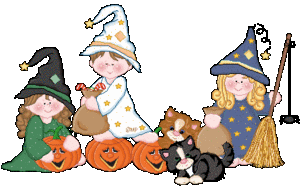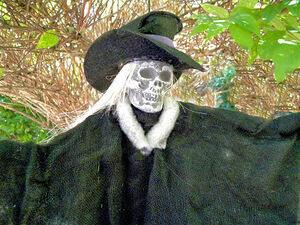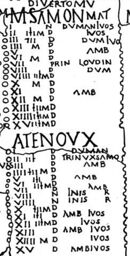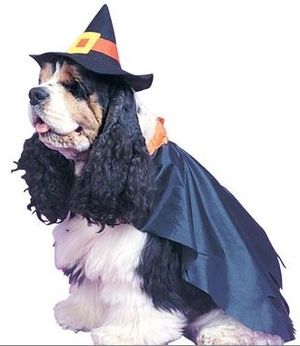Halloween
 From Conservapedia
From Conservapedia 
Connecting Halloween to Samhain, Ireland's All Saints Day, and portraying this holiday as pagan was once a way to discredit Catholic practice. In modern times, the same theories serve a neo-pagan agenda. Both groups end up portraying the devoutly Catholic Ireland of the 18th and 19th centuries as a land of paganism.
The earliest descriptions of Halloween as a festival refer, not to Ireland at all, but to late 18th century Scotland. The festival combines elements of several holidays that were suppressed in the 16th century as a result of the Reformation. The spread of the holiday owes much to a poem written by Robert Burns in 1785. With the Industrial Revolution crushing long-established traditions, the Victorians turned to revivalism to retain connection with the past. The modern child-oriented version of the holiday was established by the early 1900s.
Contents
- 1 Etymology
- 2 Customs
- 3 History
- 3.1 Bonfires
- 3.2 The Enlightenment
- 3.2.1 Tamlane
- 3.2.2 John Mayne and Robert Burns
- 3.3 Victorian revivalism
- 3.4 Samhain
- 3.5 American Halloween
- 3.6 World War II
- 3.7 Recent
- 4 Further reading
- 5 References
- 6 See also
- 7 External links
Etymology[edit]
"Hallow" means saint. All Saints' Day, November 1, was formally called "Hallowmas" or "All Hallows." "Eve" means the day before. "Hallows' Eve," which became "Hallowe'en" in Scottish usage, is therefore the day before All Saints' Day, i.e. October 31.
The earliest mention of Halloween in the Oxford English Dictionary is a 1556 entry in Chronicle of Greyfriars. This entry spells the word as "Halhalon evyn." [1] In Measure for Measure (1603) by William Shakespeare, Pompey asks Froth if another character died on "Hallowmas." Froth responds "All-hallond eve," meaning that the character died on the day before All Saints' Day.[2]
As the word is used to indicate a date rather than a festival in both of these examples, it is likely that the festival was not known in England at this time.
Customs[edit]

Church views on this holiday are varied: some consider it pagan and refuse to have any association with it, while others see it as an opportunity for outreach to children and their parents. Among the latter, some churches encourage members to pass out tracts along with candy, others offer "trunk-or-treat" (or "fall festival") events to provide a safe environment for children).
The colors orange and black are associated with Halloween, as well as costumes of witches, ghosts, famous monsters, skeletons, and devils. Seasonal foods include caramel apples, pumpkins, pumpkin pie, caramel corn, and candies.
History[edit]
In medieval times, it was thought that the living could help the souls of the dead escape purgatory on All Souls' Day on November 2 by lighting bonfires and by other activities. When the Reformation swept Scotland in May 1559, All Souls' Day was suppressed along with other Catholic holidays. "Halloween" was understood simply as the day before All Saints Day thus avoided suppression.
Bonfires[edit]
Bonfires are one of the oldest and most persistent Halloween observances. They were not only a holiday observance, but also a way to dispose of brush in the autumn. The practice could have transferred from All Souls Day to Halloween at the time of the Reformation.
Worried that a Halloween bonfire might get out of hand, the Cupar Presbytery in Fife issued this order in 1649:
| “ | It is recommended to severall brethren to be carefull to intimat in their several kirkis, wpon the Sabaths immediatly before Midsommer and hallowewen, that no fyres be set on, wpon these nightis.[3] | ” |
| “ | Hallow eve is also kept sacred: as soon as it is dark, a person sets fire to a bush of broom fastened round a pole; and, attended with a crowd, runs round the village. He then flings it down, keeps great quantity of combustible matters in it, and makes a great bonfire. A whole tract is thus illuminated at the same time, and makes a fine appearance.[4] | ” |
The Enlightenment[edit]
With the Enlightenment, belief in ghosts, goblins, and witches waned. Scotland's last execution for witchcraft was in 1706 and the last trial was in 1727. In the late 18th century, the supernatural beings that had terrified previous generations were gradually reduced to folklore. The Battle of Quiberon Bay in 1759 marked the end of the Jacobite wars and the beginning of a period of Anglo-Scottish reconciliation.
Tamlane[edit]

The ballad is mentioned by Robert Wedderburn in 1549.[6] The lyrics were collected and published by David Herd in 1769.[7] Sir Walter Scott published the classic version in 1803.[8]
John Mayne and Robert Burns[edit]
A poem written in 1780 by John Mayne of Dumfries describes a Scottish Halloween festival. The poem mentions both pranks and trick or treating. “There’s few [festivals] in Scotland held mair dear,” it says.[9] Mayne gave an explanation of the holiday in a footnote:
| “ | Hallow-E'en, or Holy Eve, is the evening previous to the celebration of All Saints. That it is propitious to the rites of divination, is an opinion still common in many parts of Scotland. | ” |
Victorian revivalism[edit]
If the holiday itself originated in Scotland, the eerie rituals of the modern Halloween celebration are the child of Victorian England. The Victorians were fond of reviving quaint customs that never were, and Halloween costume parties became popular in the late 19th century. An illustrated guide published in 1887 provided costume ideas.[11]
Samhain[edit]
That Halloween originated as the day before All Saints' Day might seem a straightforward explanation. But popular history points to another source: The pagan festival of Samhain, observed by the ancient Celts on November 1.[12]
The earliest mention of Samhain in surviving literature is found in "The Sick-Bed of Cuchulain," which dates from the tenth or eleventh centuries. It portrays Samhain as a harvest festival held at "summer's end:"[13]
| “ | [The young men of Ulster] used to keep that festival every year; nor was there anything in the world that they would do at that time except sports, and marketings, and splendours, and pomps, and feasting and eating; and it is from that custom of theirs that the Festival of the Samhain has descended, that is now held throughout the whole of Ireland.[14] | ” |
While others partied, Ulster hero Cuchulain was recovering from injuries and receiving an extended vision of Mag Mell, the Plain of Delight, a Celtic version of the Elysian fields.
American Halloween[edit]

By the middle of the 19th century, Americans substituted pumpkins for turnips and secular costumes for those of saints. By the 1920s, there were community efforts to sanitize the carnival spirit and reduce vandalism. Trick-or-treating became common around 1940. It further transformed Halloween into a rite of consumerism and moving the age profile to younger children.
World War II[edit]
Halloween flourished as an inexpensive fall festival that did not involve travel. Cities made it into "Conservation Day" and Halloween parties were enlisted in the war effort. Civic parties were held with patriotic admission prices, such as 150 pounds of salvaged paper. Towns turned Halloween parades into celebrations of civic volunteering, featuring Red Cross Units, Air Raid Wardens, and Auxiliary Police Units, all in costume. The climax of the parade was typically a War Bond Auction with prizes donated by local merchants and sold for war bond pledges.[16]
Recent[edit]
Starting in the 1960s trick-or-treating declined in some places. It was closely monitored because of (false) rumors of poisoned treats.;[17] "The Razor Blade in the Apple" was a made-up urban legend that truly frightened parents,[18] and in the 1990s the holiday has increasingly drawn upon the cult-horror genre for its inspiration. Halloween in America by the late 20th century was a big moneymaker for candy makers and costumers.
Further reading[edit]
- Hybertsen, Karen Sue. "'The Return of Chaos': The Uses and Interpretations of Halloween in the United States from the Victorian era to the Present", Drew University, ProQuest Dissertations Publishing, 1993. 9331586.
- Rogers, Nicholas. Halloween: From Pagan Ritual to Party Night (2003) excerpt and text search
- Santino, Jack. "Halloween in America: Contemporary Customs and Peformances," Western Folklore 1983 42(1): 1-20, in JSTOR
- Santino, Jack, ed. Halloween and Other Festivals of Death and Life, (U. of Tennessee Press, 1993). 280 pp. academic study
References[edit]
- ↑ Chronicle of Greyfriars (1556) 17 “Thys yere the towne of Depe was tane [taken] by the Armenobis [Armeniacs] on Halhalon evyn.”
- ↑ Shakespeare, William, Measure for Measure (1603), ii. i. 130.
- ↑ Cupar Presbytery Minutes, 8 March 1649, CH2/82/1.
- ↑ Pennant, Thomas, A Tour in Scotland, Part II (London, 1772), p. 47.
- ↑ For a brief version of the story, see "Tamlane: A Story from an Old Scotch Ballad" (1920) by Katharine Pyle.
- ↑ Wedderburn, Robert, The Complaynt of Scotlande (1549). Wedderburn lists “The tayl of the yong Tamlene” among various songs and ballads.
- ↑ Herd, David, Ancient and Modern Scots Songs, Heroic Ballads, &c., 1769, “Kertonha, or, The Fairy Court.”
- ↑ Walter, Scott, Sir, The Minstrelsy of the Scottish Border, "The Young Tamlane", p. 337.
- ↑ Mayne, John, "Halloween" (1780).
- ↑ A Short Analysis of Robert Burns’s ‘Halloween’", Interesting Literature
- ↑ "26 Halloween Costume Ideas from an 1887 Guide to Fancy Dress."
- ↑ For a "popular history" account, see "Samhain: Seven facts about the spooky Irish festival which became Halloween", Irish Post.
- ↑ "Summer's end" is a mistranslation of Irish Samhain. The word is actually from Proto-Celtic *samani meaning "assembly." See Matasović, Ranko, Etymological Dictionary of Proto-Celtic (2009).
- ↑ Maelmuiri mac Ceileachair, "The Sick-Bed of Cuchulain." The translation is from Heroic Romances of Ireland. Vol I. A. H. Leahy, ed. London: David Nutt, 1905. pp. 57-85.
- ↑ Hybertsen (1993), p. 10.
- ↑ Hybertsen (1993), p. 152
- ↑ There was only one confirmed case of Halloween candy being poisoned resulting in a child's death; the culprit was the child's father seeking to collect on an insurance policy, who was arrested and ultimately executed for his actions.
- ↑ Joel Best and Gerald T. Horiuchi, "The Razor Blade in the Apple: the Social Construction of Urban Legends," Social Problems 1985 32(5): 488-499
See also[edit]
- Day of the Dead
- Samhain
- All Saints Day
External links[edit]
- The Hell House Outreach Kit, from an Assemblies of God church near Denver
Categories: [Holidays]
↧ Download as ZWI file | Last modified: 02/16/2023 14:23:54 | 26 views
☰ Source: https://www.conservapedia.com/Halloween | License: CC BY-SA 3.0
 ZWI signed:
ZWI signed: KSF
KSF